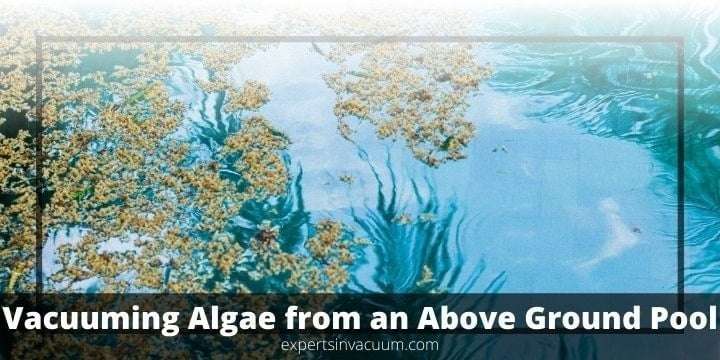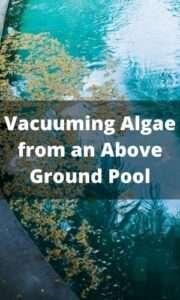
Looking to keep your above ground pool sparkling clean this summer? Vacuuming algae might seem like a daunting task, but fear not! In this ultimate guide, we’ll walk you through the simple steps to banish algae from your pool using a vacuum. Whether you’re a seasoned pool pro or a newbie, this guide has got you covered. Let’s dive in and make your pool maintenance a breeze!
In this post we will cover:
- What is Pool Algae?
- How do you Vacuum Algae from an Above Ground Pool
- How do I vacuum dead algae in my pool?
- What do the different colors of algae mean?
- Does vacuuming remove algae from a pool?
- How do you vacuum your pool manually?
What is Pool Algae?
Algae, a plant-like organism, manifests in swimming pools as green, black, mustard, or red types. Green algae, prevalent in poorly maintained pools, turns water and walls green but is easily eliminated with chlorine or algaecide.
Black algae, with deep roots and a protective layer, requires extensive treatment involving acid, chlorine, and vigorous brushing. Mustard algae, often mistaken for sand or pollen, thrives in shaded areas and demands super shocking with high doses of acid and chlorine for removal.
Red algae, entering pools via swimmers and environmental factors, pose health risks if untreated. Vigilant treatment is essential to prevent algae overgrowth.
How do you Vacuum Algae from an Above Ground Pool: The Ultimate Guide
Preliminaries
To effectively vacuum your pool, gather a vacuum head, telescopic pole, vacuum hose, and skim vac. Begin by attaching the vacuum head to the pole, then connect the hose to the vacuum. For pools with skimmers, attach the skim vac to the hose’s other end, ensuring no air remains.
If your pool lacks a skimmer, seal it with the skimmer lid. Next, submerge the assembly into the pool and expel any air from the hose. Avoid placing the hose directly into the skimmer hole to prevent potential damage.
Finally, open the skimmer lid and position the skim vac over the basket for optimal cleaning.
Vacuuming Algae
Step 1: First remove all debris from your pool, then add chemicals to the water and brush the walls and other surfaces of the pool. If you have algae in your pool, you will need to vacuum it up to waste. If you are vacuuming to waste and have a sand filter, set it to the “waste” option.
The option will enable you to vacuum up the algae and prevent it from getting into your sand filter as it will be sent out via the backwash line.
Do not allow your water line to fall below the skimmer, but you will have to vacuum faster since water will exit your pool quickly. You will have to put your garden hose into the pool to fill it up or add fresh water after vacuuming the pool.
Alternatively, you can leave the setting filter on and turn the pump on to start vacuuming. The method is beneficial as no water will be lost this way.
Step 2: Vacuum your pool in the same manner that you would your living room to pick up algae and other debris as you go. Give more attention to the areas of the pool worst affected by the algae.
Manually vacuum the pool by directly cleaning the waste, bypassing the filter, and avoiding the recirculation of the water that is contaminated. Push the head of the vacuum around the floor of the pool and the sides while holding the pole to eliminate the algae.
Step 3: When you are done vacuuming, disconnect the hose from the filter, turn the pump off, and then take your vacuuming equipment and store them.
Step 4: Empty all the baskets of the skimmer. If you vacuumed on waste, turn on your filter setting to “rinse.” Then turn the pump on and leave it to run for 30 seconds before turning it off again. After this, ensure the filter setting is turned back on.
Step 5: If you have a cartridge filter, use a garden hose to spray the cartridges out and put them back onto the filter.
Step 6: If not, restart the pump and you’re done.
The waste method: To efficiently remove algae from an above-ground pool, the vacuuming to waste method proves safest and easiest. This technique involves bypassing the filter, utilizing a multiport system or installing a waste line, to directly expel debris.
Ensure the water level remains above six inches from the pool’s tile to prevent damage. If levels drop, halt the process, refill, and resume cleaning. This method guarantees thorough algae removal without burdening the filtration system.
Whether you opt for a multiport system or install a waste line, maintaining proper water levels is key for optimal results.
The filter method: Maintaining a clean pool is crucial for its longevity and your enjoyment. When vacuuming, use an old cartridge to catch debris, replacing it if necessary. If debris bypasses the filter, clean or repair it promptly.
After vacuuming and adjusting water levels, restart the system gradually to avoid recirculating dirt. Replace the filter if needed, ensuring it’s cleared by water. Then, add half a gallon of acid and bleach to circulate for 24 hours.
This method ensures thorough cleaning and prevents algae buildup, keeping your pool pristine for leisure and health.
How do I vacuum dead algae in my pool?
To efficiently eliminate dead algae from your pool, several methods can be employed. Firstly, brushing the pool walls with a suitable brush helps loosen and remove clinging algae.
Secondly, adding flocculant to the water causes algae to coagulate and sink, facilitating removal with a vacuum.
When vacuuming, utilizing the waste setting on a multiport system or a disposable filter is effective. This ensures algae bypasses the filter, preventing clogs and damage.
Regular maintenance using these methods keeps pools clean and safe for enjoyment, enhancing the overall experience for all pool owners.
FAQs
What do the different colors of algae mean?
Algae growth in pools progresses through three stages, each indicated by distinct colors. Light green algae signify the initial stage, necessitating pool shocking to eradicate it, as it thrives in high pH environments.
Dark green algae mark the second stage, requiring a higher dose of chlorine and acid for treatment. This hue may also indicate stagnant debris, necessitating cleaning before treatment.
Finally, black-green algae denote the advanced stage, demanding thorough debris removal and triple the dosage for effective treatment.
Regular monitoring, pH level adjustment, and prompt action ensure a clean and inviting pool for all.
Does vacuuming remove algae from a pool?
Algae can be difficult to eliminate from your pool, especially in crevices and corners. Vacuuming is a good way of eliminating algae from your pool, but vacuuming alone will not get rid of all the algae in your pool. However, it does help in the prevention of algae.
You will also have to remove debris such as leaves and other organic matter to discourage algae growth and keep the water in your pool clean. The vacuuming will keep your pool water balanced.
Therefore, you cannot completely remove algae from your pool by vacuuming unless all other debris has been removed using a net. After that, add chemicals to the water and brush the surfaces and walls of the pool.
How do you vacuum your pool manually?
Manual pool vacuuming requires careful priming to optimize suction. Attach the vacuum head to a pole, then purge air by pressing the hose against a jet. Begin cleaning from the shallow end, using slow, overlapping strokes to prevent debris from settling.
Rushing can stir up debris, clouding the water. Allow time for debris to settle before continuing. Monitor the pressure gauge; if it exceeds the recommended level, backwash the filter.
If the vacuum head gets stuck, switch off the pump. With patience and attention to detail, maintaining a clear pool is achievable.
How frequently should a swimming pool be vacuumed and maintained?
Regular pool maintenance is essential for a sparkling oasis. Vacuuming weekly is crucial, especially after heavy storms, to clear dirt and debris. Incorporating smaller tasks throughout the month helps prevent maintenance overload.
Vacuuming twice a week and testing pH levels weekly, aiming for 7.4 to 7.6, keeps water pristine. Skimming for debris, cleaning tiles, and brushing walls maintain cleanliness. Shocking the pool weekly ensures sanitation.
By adhering to these practices, you’ll enjoy a safe, pH-balanced, and inviting pool environment, perfect for relaxation and recreation.
The Wind-Up
So there you have it – a comprehensive guide on removing algae from your above ground pool! With these simple steps, you can keep your pool sparkling clean and ready for fun all season long. Don’t let algae ruin your swim time; tackle it head-on and enjoy crystal-clear water every time you take a dip. Happy swimming!

